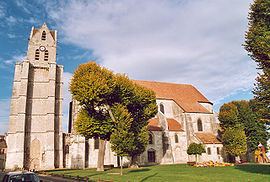Country Region Ile-de-France | Area 22,679 Mayor | |
 | ||
Cambriolage installation de portes blindees etampes
Étampes ([etɑ̃p]) is a commune in the metropolitan area of Paris, France. It is located 48.1 km (29.9 mi) south-southwest from the center of Paris (as the crow flies). Étampes is a sub-prefecture of the Essonne department.
Contents
- Cambriolage installation de portes blindees etampes
- Map of tampes
- History
- Geography
- Transport
- Sights
- Religious edifices
- Notable Persons
- Miscellaneous
- References
Map of Étampes
Étampes, together with the neighboring communes of Morigny-Champigny and Brières-les-Scellés, form an urban area of 26,604 inhabitants (1999 census). This urban area is a "satellite city" of Paris.
History
Étampes (Latin: Stampae) existed at the beginning of the 7th century and in the early Middle Ages belonged to the crown domain. During the Middle Ages it was the scene of several councils, the most notable of which took place in 1130 and resulted in the recognition of Innocent II as the legitimate pope. In 1652, during the war of the Fronde it suffered severely at the hands of the royal troops under Turenne.
Geography
Étampes lies on the beautiful river Chalouette, a tributary of the Juine, which borders the eastern outskirts of the serene town.
Inhabitants of Étampes are known as Étampois.
Transport
Étampes is served by two stations on Paris RER line C: Étampes and Saint-Martin d'Étampes.
Sights
A fine view of Étampes is obtained from the Tour Guinette, a keep (now ruined) built by Louis VI in the 12th century on an eminence on the other side of the railway. Notre-Dame du Fort, the chief church, dates from the 11th and 12th centuries; irregular in plan, it is remarkable for a fine Romanesque tower and spire, and for the crenellated wall which partly surrounds it. The interior contains ancient paintings and other artistic works. St Basile (12th and 16th centuries), which preserves a Romanesque doorway, and St Martin (12th and 13th centuries), with a leaning tower of the 16th century, are of less importance.
The civil buildings offer little interest, but two houses named after Anne de Pisseleu, mistress of Francis I, and Diane de Poitiers, mistress of Henry II, are graceful examples of Renaissance architecture. In the square there is a statue of the naturalist, Étienne Geoffroy Saint-Hilaire, who was born in Étampes.
Religious edifices
Notable Persons
Miscellaneous
The subprefecture, a tribunal of first instance, and a communal college are among the public institutions of Étampes.
